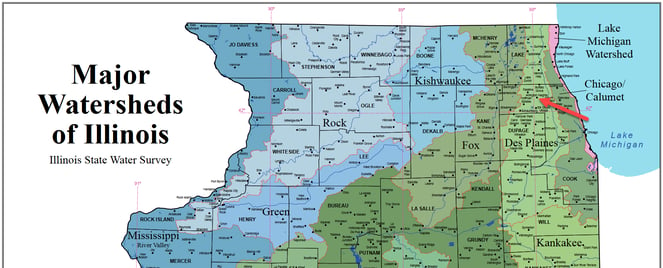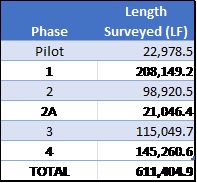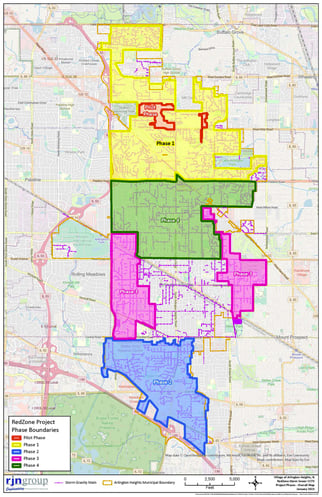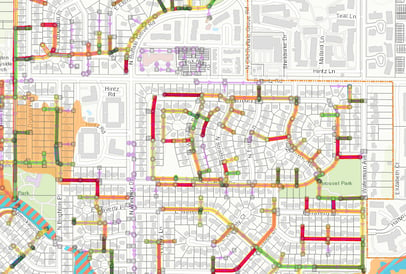(630) 682-4700
2655 Warrenville Road, Suite 225, Downers Grove, IL 60515
Better information about your collection, water, and stormwater systems
Explore ClarityBetter information about your collection, water, and stormwater systems
Explore Clarity
Mr. Young's engineering focus is extending the service life of water, sewer, a...
Historically, municipal storm and drainage system maintenance programming has not been a spotlight for asset owners. Storm water systems are designed to minimize storm impacts for community residents and businesses, but when they fail can have catastrophic safety and environmental impacts, like sinkholes opening in heavily traveled streets. Building an asset inventory provides the "what" and "where" framework for each asset, but knowing when proactive maintenance is needed requires understanding asset conditions. A program to develop the what, where, and when presents a unique set of challenges.
The Village of Arlington Heights, Illinois (VAH), is a community of approximately 75,000 residents northwest of Chicago. The Village, located in the Des Plaines River watershed, has a mix of separate sanitary sewers (≈920,000 LF)and separate storm sewers (≈1,100,000 LF) as well as a combined sewer (≈350,000 LF) in the older downtown area. The sanitary and combined flows discharge to the Metropolitan Water Reclamation District of Greater Chicago (MWRD) for treatment, while the separate storm sewer system discharges to area streams and waterways.

In 2015, the Village’s Utility Superintendent realized the Village did not have a robust storm sewer asset inventory and wanted to understand what infrastructure they had, where it was located, and the condition it was in.
The Village determined that a combination of storm sewer televising (CCTV) and select surveys and inspections of manholes and structures would provide the information needed to update the Village GIS with accurate GPS locations, asset attributes, and condition data. They hired the team of RedZone Robotics (RZ) and RJN Group to conduct the inspections and build the GIS asset inventory through a phased program.
The project was initiated w ith a small pilot area and then expanded into four areas (the rest of the separate storm sewer system) with a goal of completing the inventory in four years.
ith a small pilot area and then expanded into four areas (the rest of the separate storm sewer system) with a goal of completing the inventory in four years.
Initially, RedZone’s SOLO® pipeline inspection robot camera system was used to record conditions in the manholes and for the 8 to 12-inch sewers. Standard CCTV cameras inspected sewers larger than 12 inches, and multi-sensor inspections (MSI) were conducted in larger sewers with flows present.
The primary Village goal for the program was to incorporate all captured findings—asset locations, details, and conditions, including NASSCO PACP condition ratings—in their in-house GIS to make it easily accessible to Village staff for operations and maintenance programming and capital planning. This required converting and integrating data from the standard RedZone ICOM® software deliverable.

Work began in early 2016 in the pilot area and continued through the four phases shown above.
Developing a comprehensive storm sewer asset inventory presented unique challenges during data collection and management.
Regular interactive coordination between RZ field staff, RZ coding staff, VAH GIS staff, VAH PW staff, RJN GIS staff, RJN field staff, and Village GIS consultants was critical.
- VAH staff assigned inspection areas and provided available mapping data
- RZ conducted the CCTV and MSI inspections, and initial manhole inspections
- RJN performed manhole surveys, integrated inspection results with the GIS, and enhanced the GIS
- Village GIS consultant (fourth entity)
Navigating these challenges did delay the program. The asset survey, attributes, and condition data were collected and incorporated into the Village GIS at a slower rate than initially planned. The Utility Superintendent driving the program did retire in Jan 2021, and the project was completed in December 2022.
The VAH storm asset inventory is now a viable planning tool for the future, the storm sewers were cleaned, and the storm sewer video, inspection reports, pictures, and NASSCO condition ratings are easily accessible in the single-source GIS platform.


Mr. Young's engineering focus is extending the service life of water, sewer, a...